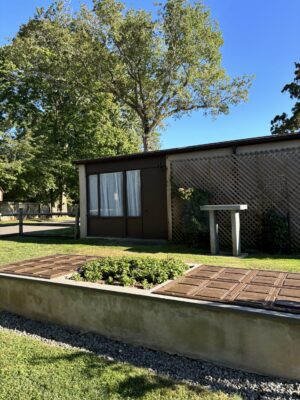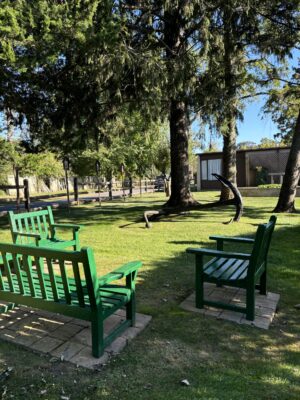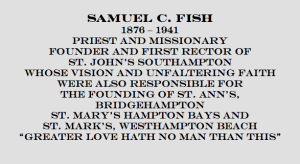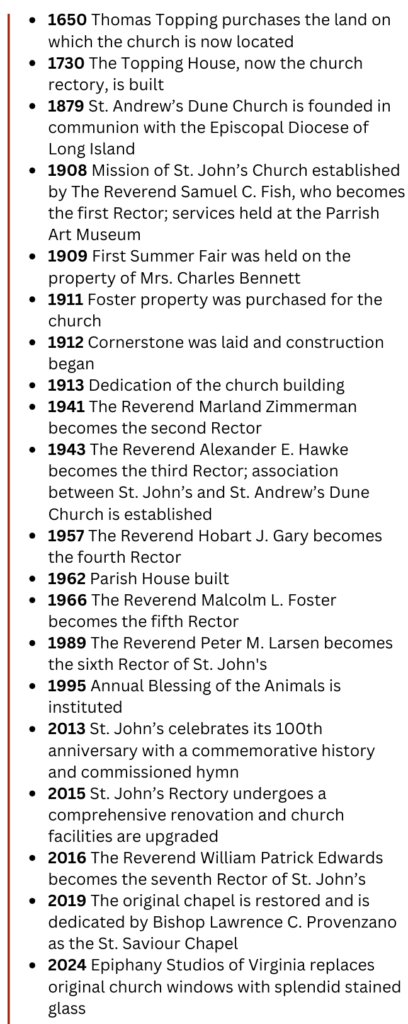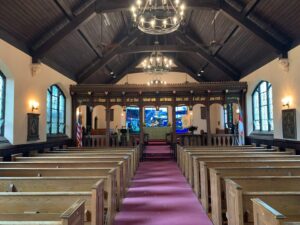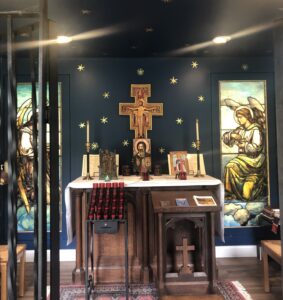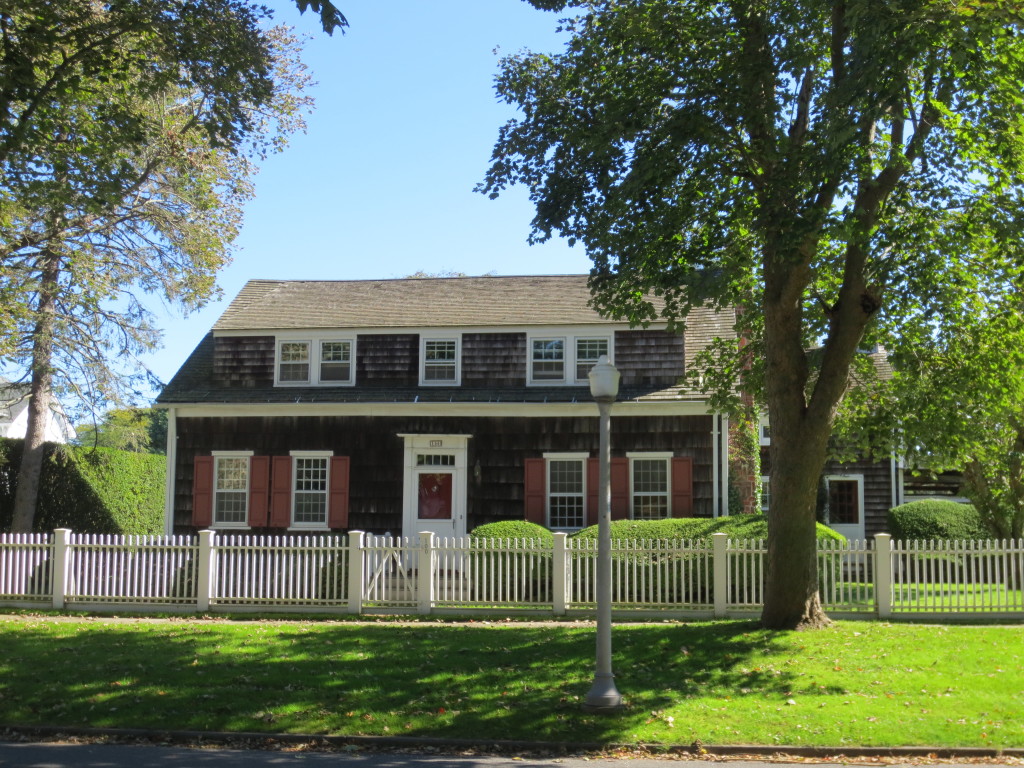A plaque in St. John’s commemorates our founder.
Thomas Topping purchased the land on which St. John’s Episcopal Church is sited from the Shinnecock Indians in 1650.
In 1911 the owner at that time, Albert Foster, sold it to the Mission of St. John’s Church which was temporarily holding services in the Parrish Art Museum under the direction of Vicar Samuel C. Fish who established the Mission in 1908.
The groundbreaking ceremony for a new church took place on August 18, 1912, and construction began that October. Major funding came from St. Andrew’s Dune Church which was founded in 1879. This gift began a dynamic and complex relationship that flourishes to this day.
After the massive hurricane of 1938 heavily destroyed the Dune Church, an amalgamation with St. John’s was discussed. St. Andrew’s, founded in a former lifesaving station as an independent corporation under civil legislation known as the “Free Church Act,” was not a member of the diocese.
In 1943, Bishop James deWolfe of the Episcopal Diocese of Long Island put forward a cooperative plan that preserved the autonomy of the governing bodies of both churches. The Rector of St. John’s would preach at the Dune Church at least once a summer and regularly assist in the Sunday services there. Our close association began.
Now, during the summer months, St. John’s Rector conducts an 11:00 am service at St. Andrew’s during which visiting clergy preach at the invitation of St. Andrew’s trustees, and a seasonal congregation joins St. John’s parishioners in worship at the Dune Church, where God’s glorious dunes meet the unfathomable sea.
Read more about the rich history of St. John’s in a booklet commemorating our 100th anniversary, Brief Notes, by Carroll Moulton here.
THE CHURCH
The Roman Gothic high church style building remains today much as it was in 1912. In the last year, most of the original windows were replaced. Eleven now have original stained glass designed and created by the acclaimed Epiphany Studios of Virginia. Biblical and other sacred scenes are featured amid clear glass surrounds, allowing plenty of God’s light to shine in. As part of the window refurbishment project, a friend of the parish has donated two significant works by 20th century artist Margaret Redmond depicting the Annunciation and The Visit of the Magi.
THE CHAPEL
The original chapel, located adjacent to the church in the Parish House, was restored thanks to the vision and guidance of Father Patrick and his wife Deborah. New windows, a refurbished altar, and hand-painted details created our newest sacred space. In 2019 Bishop Lawrence C. Provenzano dedicated it as St. Saviour’s Chapel.
THE PARISH HOUSE
Built in 1962, The Parish House connects directly to the church and serves as an active hub for gatherings. It is available to the public free of charge for gatherings and meetings. The space includes a fully equipped downstairs kitchen and dining room for 100 and an upstairs living room, galley kitchen and five classrooms. An enclosed space for a secretary and a private minister’s office complete the layout.
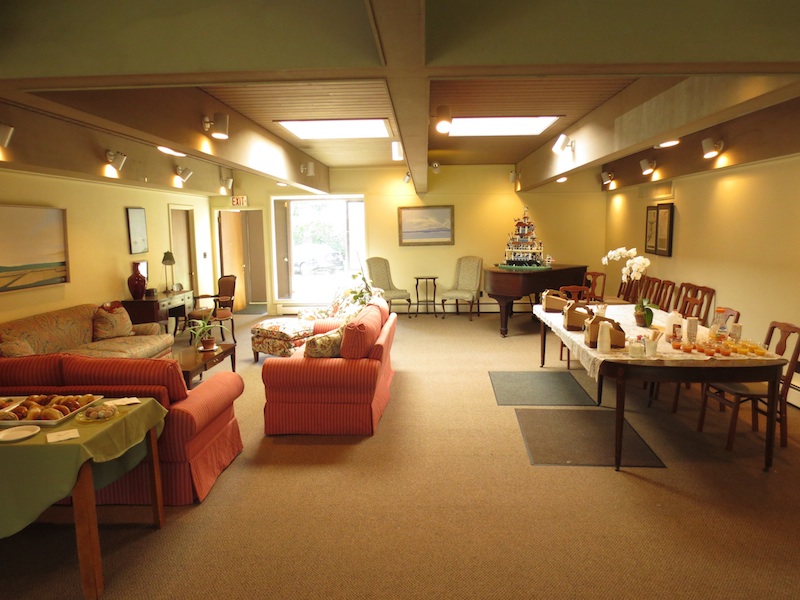
THE RECTORY
Located next to the church and Parish House, the rectory is an historic and truly charming family residence. The home has five bedrooms, a living room, family room, kitchen, study, and four-and-a-half bathrooms, plus a covered terrace and a private yard. The original house was built by the Topping
family in 1730. Now a wing of the current rectory, it is used as the dining room and shows its original wainscoting and oven-fireplace intact. The main part of the house was built in 1750. In 2015 a complete renovation of the rectory was undertaken. The entire house and roof were re-shingled, all windows
were replaced, a new heating and air conditioning system was installed, four bathrooms were renovated and one added, floors were redone and kitchen appliances upgraded. Local contractors and vendors, many of whom are members of St. John’s congregation, were hired for the work. A local Southampton historian authored a history of the building for the church’s permanent records noting that it, “retains a very high level of integrity…is a very valuable historic resource to the Village…and is an authentic piece of early American 18th century history…”
COLUMBARIUM & MEMORIAL GARDEN
The newest addition to the property is a Columbarium surrounded by a beautiful Memorial Garden. In 2023, a parishioner designed the landscape of the garden and donated its plantings. The garden includes a 200-year-old whaling pot and anchor donated by the Trustees of St. Andrew’s Dune Church. The in-ground Columbarium, completed the same year, comprises 32 spaces with room for expansion. An altar, donated by a parishioner, memorializes her husband who was a former Vestry member. Fourteen pillars supporting images of the stations of the cross surround the garden perimeter.
